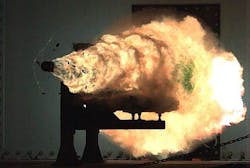Navy asks industry for rugged, high-G electronics and guidance for Hyper Velocity Projectile program
ARLINGTON, Va., 1 Aug. 2012. U.S. Navy researchers are asking industry to develop extremely rugged miniature guidance systems and electronics for future hyper-velocity munitions that produce launch forces of 20,000 to 30,000 Gs and travel more than 30 miles to their targets.
The U.S. Office of Naval Research (ONR) is kicking off the Hyper Velocity Projectile program, which seeks to develop rugged electronics, strong materials, and warheads for accurate high-velocity weapons that do not need rocket propulsion to reach and destroy distant targets.
ONR officials will brief industry about the Hyper Velocity Projectile program on 20 Aug. 2012 in Arlington, Va. Register to attend the industry day no later than 3 Aug. -- this coming Friday -- by e-mail to the Navy's Sarwat Chappell at [email protected]. Include a letter outlining company expertise and names of those who plan to attend.
The Navy's Hyper Velocity Projectile program will explore extended-range guided projectile technologies for naval surface fire support and capitalize on recent advances in miniaturized electronics, guided projectiles and mortars, and warhead technology for small unmanned aerial vehicle (UAV)- launched munitions.
The program will pursue projectile guidance for conventional guns such as the Mk 45 and 155-millimeter Advanced Gun System and 155-millimeter field artillery and future electromagnetic railgun designs. In addition, projectile designs and technologies also must be applicable to potential in-flight retargeting of naval gunfire, cruise missile defense, anti-ship warfare.
Future high-velocity, extended-range naval munitions will require research breakthroughs in high-G electronic packaging and control systems in a small form factors, yet the potential payoffs are great, Navy officials say. High-velocity munitions will not need rocket motors, which could reduce collateral damage, promote deeper magazines, and reduce munitions costs. cost of the projectile, Navy officials say.
The Hyper Velocity Projectile program will develop a guided hypervelocity projectile that can be fired from the Navy's Mk 45 155-millimeter gun systems and future 20 – 32MJ railgun systems. To fit the Mk 45, the high-velocity projectile shall be a 62-centimeter subcaliber saboted round. The projectile and its guidance subsystems must be able to survive 20,000 to 30,000 Gs of launch acceleration at ranges longer than 30 nautical miles.
The ONR HVP program will address technologies for high-G miniaturized guidance electronics and control actuation systems, militarized GPS receivers, compact fuzing, high-density electronics packaging, advanced energetics, lightweight-high strength composite materials, and heat resistive-thermal managing materials.
Companies interested in participating in the Hyper Velocity Projectile program should send white papers to ONR no later than 31 Aug. 2012 to Sarwat Chappell at [email protected]. E-mail questions or concerns to Sarwat no later than 20 Aug. 2012.
More information is online at https://www.fbo.gov/spg/DON/ONR/ONR/12-SN-0017/listing.html.
Follow Military & Aerospace Electronics and Avionics Intelligence news updates on Twitter
